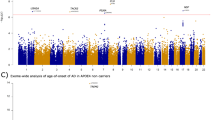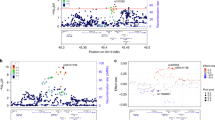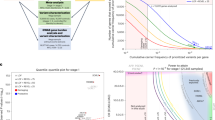Abstract
Whole-exome sequencing of individuals with mild cognitive impairment, combined with genotype imputation, was used to identify coding variants other than the apolipoprotein E (APOE) ɛ4 allele associated with rate of hippocampal volume loss using an extreme trait design. Matched unrelated APOE ɛ3 homozygous male Caucasian participants from the Alzheimer’s Disease Neuroimaging Initiative (ADNI) were selected at the extremes of the 2-year longitudinal change distribution of hippocampal volume (eight subjects with rapid rates of atrophy and eight with slow/stable rates of atrophy). We identified 57 non-synonymous single nucleotide variants (SNVs) which were found exclusively in at least 4 of 8 subjects in the rapid atrophy group, but not in any of the 8 subjects in the slow atrophy group. Among these SNVs, the variants that accounted for the greatest group difference and were predicted in silico as ‘probably damaging’ missense variants were rs9610775 (CARD10) and rs1136410 (PARP1). To further investigate and extend the exome findings in a larger sample, we conducted quantitative trait analysis including whole-brain search in the remaining ADNI APOE ɛ3/ɛ3 group (N=315). Genetic variation within PARP1 and CARD10 was associated with rate of hippocampal neurodegeneration in APOE ɛ3/ɛ3. Meta-analysis across five independent cross sectional cohorts indicated that rs1136410 is also significantly associated with hippocampal volume in APOE ɛ3/ɛ3 individuals (N=923). Larger sequencing studies and longitudinal follow-up are needed for confirmation. The combination of next-generation sequencing and quantitative imaging phenotypes holds significant promise for discovery of variants involved in neurodegeneration.
This is a preview of subscription content, access via your institution
Access options
Subscribe to this journal
Receive 12 print issues and online access
$259.00 per year
only $21.58 per issue
Buy this article
- Purchase on Springer Link
- Instant access to full article PDF
Prices may be subject to local taxes which are calculated during checkout



Similar content being viewed by others
References
Thies W, Bleiler L 2011 Alzheimer’s disease facts and figures. Alzheimers Dement 2011; 7: 208–244.
Blennow K, de Leon MJ, Zetterberg H . Alzheimer’s disease. Lancet 2006; 368: 387–403.
Hardy J, Selkoe DJ . The amyloid hypothesis of Alzheimer’s disease: progress and problems on the road to therapeutics. Science 2002; 297: 353–356.
Bergem AL . Heredity in dementia of the Alzheimer type. Clin Genet 1994; 46 (1 Spec No): 144–149.
Bergem AL, Engedal K, Kringlen E . The role of heredity in late-onset Alzheimer disease and vascular dementia. A twin study. Arch Gen Psychiatry 1997; 54: 264–270.
Gatz M, Pedersen NL, Berg S, Johansson B, Johansson K, Mortimer JA et al. Heritability for Alzheimer’s disease: the study of dementia in Swedish twins. J Gerontol A Biol Sci Med Sci 1997; 52: M117–M125.
Bertram L, Tanzi RE . Thirty years of Alzheimer’s disease genetics: the implications of systematic meta-analyses. Nat Rev Neurosci 2008; 9: 768–778.
Abraham R, Moskvina V, Sims R, Hollingworth P, Morgan A, Georgieva L et al. A genome-wide association study for late-onset Alzheimer’s disease using DNA pooling. BMC Med Genomics 2008; 1: 44.
Beecham GW, Martin ER, Li YJ, Slifer MA, Gilbert JR, Haines JL et al. Genome-wide association study implicates a chromosome 12 risk locus for late-onset Alzheimer disease. Am J Hum Genet 2009; 84: 35–43.
Bertram L, Lange C, Mullin K, Parkinson M, Hsiao M, Hogan MF et al. Genome-wide association analysis reveals putative Alzheimer’s disease susceptibility loci in addition to APOE. Am J Hum Genet 2008; 83: 623–632.
Harold D, Abraham R, Hollingworth P, Sims R, Gerrish A, Hamshere ML et al. Genome-wide association study identifies variants at CLU and PICALM associated with Alzheimer’s disease. Nat Genet 2009; 41: 1088–1093.
Lambert JC, Heath S, Even G, Campion D, Sleegers K, Hiltunen M et al. Genome-wide association study identifies variants at CLU and CR1 associated with Alzheimer's disease. Nat Genet 2009; 41: 1094–1099.
Jun G, Naj AC, Beecham GW, Wang LS, Buros J, Gallins PJ et al. Meta-analysis confirms CR1, CLU, and PICALM as alzheimer disease risk loci and reveals interactions with APOE genotypes. Arch Neurol 2010; 67: 1473–1484.
Seshadri S, Fitzpatrick AL, Ikram MA, DeStefano AL, Gudnason V, Boada M et al. Genome-wide analysis of genetic loci associated with Alzheimer disease. JAMA 2010; 303: 1832–1840.
Naj AC, Jun G, Beecham GW, Wang LS, Vardarajan BN, Buros J et al. Common variants at MS4A4/MS4A6E, CD2AP, CD33 and EPHA1 are associated with late-onset Alzheimer’s disease. Nat Genet 2011; 43: 436–441.
Hollingworth P, Harold D, Sims R, Gerrish A, Lambert JC, Carrasquillo MM et al. Common variants at ABCA7, MS4A6A/MS4A4E, EPHA1, CD33 and CD2AP are associated with Alzheimer’s disease. Nat Genet 2011; 43: 429–435.
Corder EH, Saunders AM, Strittmatter WJ, Schmechel DE, Gaskell PC, Small GW et al. Gene dose of apolipoprotein E type 4 allele and the risk of Alzheimer’s disease in late onset families. Science 1993; 261: 921–923.
Farrer LA, Cupples LA, Haines JL, Hyman B, Kukull WA, Mayeux R et al. Effects of age, sex, and ethnicity on the association between apolipoprotein E genotype and Alzheimer disease. A meta-analysis. APOE and Alzheimer Disease Meta Analysis Consortium. JAMA 1997; 278: 1349–1356.
Bu G, Apolipoprotein E . and its receptors in Alzheimer’s disease: pathways, pathogenesis and therapy. Nat Rev Neurosci 2009; 10: 333–344.
So HC, Gui AH, Cherny SS, Sham PC . Evaluating the heritability explained by known susceptibility variants: a survey of ten complex diseases. Genet Epidemiol 2011; 35: 310–317.
Manolio TA, Collins FS, Cox NJ, Goldstein DB, Hindorff LA, Hunter DJ et al. Finding the missing heritability of complex diseases. Nature 2009; 461: 747–753.
Cirulli ET, Goldstein DB . Uncovering the roles of rare variants in common disease through whole-genome sequencing. Nat Rev Genet 2010; 11: 415–425.
Cooper GM, Shendure J . Needles in stacks of needles: finding disease-causal variants in a wealth of genomic data. Nat Rev Genet 2011; 12: 628–640.
Ng SB, Buckingham KJ, Lee C, Bigham AW, Tabor HK, Dent KM et al. Exome sequencing identifies the cause of a mendelian disorder. Nat Genet 2010; 42: 30–35.
Holm H, Gudbjartsson DF, Sulem P, Masson G, Helgadottir HT, Zanon C et al. A rare variant in MYH6 is associated with high risk of sick sinus syndrome. Nat Genet 2011; 43: 316–320.
Choi M, Scholl UI, Ji W, Liu T, Tikhonova IR, Zumbo P et al. Genetic diagnosis by whole exome capture and massively parallel DNA sequencing. Proc Natl Acad Sci USA 2009; 106: 19096–19101.
Klein CJ, Botuyan MV, Wu Y, Ward CJ, Nicholson GA, Hammans S et al. Mutations in DNMT1 cause hereditary sensory neuropathy with dementia and hearing loss. Nat Genet 2011; 43: 595–600.
Kim JJ, Park YM, Baik KH, Choi HY, Yang GS, Koh I et al. Exome sequencing and subsequent association studies identify five amino acid-altering variants influencing human height. Human Genet 2012; 131: 471–478.
Pottier C, Hannequin D, Coutant S, Rovelet-Lecrux A, Wallon D, Rousseau S et al. High frequency of potentially pathogenic SORL1 mutations in autosomal dominant early-onset Alzheimer disease. Mol Psychiatry 2012; 17: 875–879.
Guerreiro RJ, Lohmann E, Kinsella E, Bras JM, Luu N, Gurunlian N et al. Exome sequencing reveals an unexpected genetic cause of disease: NOTCH3 mutation in a Turkish family with Alzheimer’s disease. Neurobiol Aging 2012; 33: 1008 e1017–1008 e1023.
Bettens K, Brouwers N, Engelborghs S, Lambert JC, Rogaeva E, Vandenberghe R et al. Both common variations and rare non-synonymous substitutions and small insertion/deletions in CLU are associated with increased Alzheimer risk. Mol Neurodegener 2012; 7: 3.
Ferrari R, Moreno JH, Minhajuddin AT, O'Bryant SE, Reisch JS, Barber RC et al. Implication of common and disease specific variants in CLU, CR1, and PICALM. Neurobiol Aging 2012; 33: 1846.
Petersen RC, Smith GE, Waring SC, Ivnik RJ, Tangalos EG, Kokmen E . Mild cognitive impairment: clinical characterization and outcome. Arch Neurol 1999; 56: 303–308.
Petersen RC, Roberts RO, Knopman DS, Boeve BF, Geda YE, Ivnik RJ et al. Mild cognitive impairment: ten years later. Arch Neurol 2009; 66: 1447–1455.
Saykin AJ, Shen L, Foroud TM, Potkin SG, Swaminathan S, Kim S et al. Alzheimer’s Disease Neuroimaging Initiative biomarkers as quantitative phenotypes: genetics core aims, progress, and plans. Alzheimer’s Dement 2010; 6: 265–273.
Kim S, Swaminathan S, Shen L, Risacher SL, Nho K, Foroud T et al. Genome-wide association study of CSF biomarkers Abeta1-42, t-tau, and p-tau181p in the ADNI cohort. Neurology 2011; 76: 69–79.
Weiner MW, Veitch DP, Aisen PS, Beckett LA, Cairns NJ, Green RC et al. The Alzheimer’s Disease Neuroimaging Initiative: a review of papers published since its inception. Alzheimers Dement 2012; 8 (1 Suppl): S1–68.
Risacher SL, Shen L, West JD, Kim S, McDonald BC, Beckett LA et al. Longitudinal MRI atrophy biomarkers: relationship to conversion in the ADNI cohort. Neurobiol Aging 2010; 31: 1401–1418.
Li H, Durbin R . Fast and accurate short read alignment with Burrows-Wheeler transform. Bioinformatics 2009; 25: 1754–1760.
DePristo MA, Banks E, Poplin R, Garimella KV, Maguire JR, Hartl C et al. A framework for variation discovery and genotyping using next-generation DNA sequencing data. Nat Genet 2011; 43: 491–498.
Wang K, Li M, Hakonarson H . ANNOVAR: functional annotation of genetic variants from high-throughput sequencing data. Nucleic Acids Res 2010; 38: e164.
Adzhubei IA, Schmidt S, Peshkin L, Ramensky VE, Gerasimova A, Bork P et al. A method and server for predicting damaging missense mutations. Nat Meth 2010; 7: 248–249.
Kumar P, Henikoff S, Ng PC . Predicting the effects of coding non-synonymous variants on protein function using the SIFT algorithm. Nat Protoc 2009; 4: 1073–1081.
Risacher SL, Saykin AJ, West JD, Shen L, Firpi HA, McDonald BC . Baseline MRI predictors of conversion from MCI to probable AD in the ADNI cohort. Curr Alzheimer Res 2009; 6: 347–361.
Jack CR Jr., Bernstein MA, Fox NC, Thompson P, Alexander G, Harvey D et al. The Alzheimer’s Disease Neuroimaging Initiative (ADNI): MRI methods. J Magn Reson Imaging 2008; 27: 685–691.
Ashburner J, Friston KJ . Voxel-based morphometry—the methods. NeuroImage 2000; 11 (6 Pt 1): 805–821.
Brand K, Eisele T, Kreusel U, Page M, Page S, Haas M et al. Dysregulation of monocytic nuclear factor-kappa B by oxidized low-density lipoprotein. Arterioscler Thromb Vasc Biol 1997; 17: 1901–1909.
Muller JM, Krauss B, Kaltschmidt C, Baeuerle PA, Rupec RA . Hypoxia induces c-fos transcription via a mitogen-activated protein kinase-dependent pathway. J Biol Chem 1997; 272: 23435–23439.
Barnes LL, Wilson RS, Li Y, Gilley DW, Bennett DA, Evans DA . Change in cognitive function in Alzheimer’s disease in African-American and white persons. Neuroepidemiology 2006; 26: 16–22.
Barnes J, Scahill RI, Schott JM, Frost C, Rossor MN, Fox NC . Does Alzheimer’s disease affect hippocampal asymmetry? Evidence from a cross-sectional and longitudinal volumetric MRI study. Dement Geriatr Cogn Disord 2005; 19: 338–344.
Howie BN, Donnelly P, Marchini J . A flexible and accurate genotype imputation method for the next generation of genome-wide association studies. PLoS Genet 2009; 5: e1000529.
Scahill RI, Schott JM, Stevens JM, Rossor MN, Fox NC . Mapping the evolution of regional atrophy in Alzheimer’s disease: unbiased analysis of fluid-registered serial MRI. Proc Natl Acad Sci USA 2002; 99: 4703–4707.
McAllister-Lucas LM, Inohara N, Lucas PC, Ruland J, Benito A, Li Q et al. Bimp1, a MAGUK family member linking protein kinase C activation to Bcl10-mediated NF-kappaB induction. J Biol Chem 2001; 276: 30589–30597.
Jones AR, Overly CC, Sunkin SM . The Allen Brain Atlas: 5 years and beyond. Nat Rev Neurosci 2009; 10: 821–828.
Wang L, Guo Y, Huang WJ, Ke X, Poyet JL, Manji GA et al. Card10 is a novel caspase recruitment domain/membrane-associated guanylate kinase family member that interacts with BCL10 and activates NF-kappa B. J Biol Chem 2001; 276: 21405–21409.
Wegener E, Krappmann D . CARD-Bcl10-Malt1 signalosomes: missing link to NF-kappaB. Science’s STKE 2007; 2007: pe21.
McAllister-Lucas LM, Jin X, Gu S, Siu K, McDonnell S, Ruland J et al. The CARMA3-Bcl10-MALT1 signalosome promotes angiotensin II-dependent vascular inflammation and atherogenesis. J Biol Chem 2010; 285: 25880–25884.
Sun J . CARMA3: A novel scaffold protein in regulation of NF-kappaB activation and diseases. World J Biol Chemistry 2010; 1: 353–361.
Kaltschmidt B, Uherek M, Volk B, Baeuerle PA, Kaltschmidt C . Transcription factor NF-kappaB is activated in primary neurons by amyloid beta peptides and in neurons surrounding early plaques from patients with Alzheimer disease. Proc Natl Acad Sci USA 1997; 94: 2642–2647.
Ruland J, Duncan GS, Elia A, del Barco Barrantes I, Nguyen L, Plyte S et al. Bcl10 is a positive regulator of antigen receptor-induced activation of NF-kappaB and neural tube closure. Cell 2001; 104: 33–42.
Strosznajder JB, Czapski GA, Adamczyk A, Strosznajder RP . Poly(ADP-ribose) polymerase-1 in amyloid beta toxicity and Alzheimer’s disease. Mol Neurobiol 2012; 46: 78–84.
Moncada S, Bolanos JP . Nitric oxide, cell bioenergetics and neurodegeneration. J Neurochem 2006; 97: 1676–1689.
Strosznajder RP, Jesko H, Zambrzycka A . Poly(ADP-ribose) polymerase: the nuclear target in signal transduction and its role in brain ischemia-reperfusion injury. Mol Neurobiol 2005; 31: 149–167.
Menissier de Murcia J, Ricoul M, Tartier L, Niedergang C, Huber A, Dantzer F et al. Functional interaction between PARP-1 and PARP-2 in chromosome stability and embryonic development in mouse. EMBO J 2003; 22: 2255–2263.
Yu SW, Andrabi SA, Wang H, Kim NS, Poirier GG, Dawson TM et al. Apoptosis-inducing factor mediates poly(ADP-ribose) (PAR) polymer-induced cell death. Proc Natl Acad Sci USA 2006; 103: 18314–18319.
Ba X, Garg NJ . Signaling mechanism of poly(ADP-ribose) polymerase-1 (PARP-1) in inflammatory diseases. Am J Pathol 2011; 178: 946–955.
Liu HP, Lin WY, Wu BT, Liu SH, Wang WF, Tsai CH et al. Evaluation of the poly(ADP-ribose) polymerase-1 gene variants in Alzheimer’s disease. J Clin Lab Anal 2010; 24: 182–186.
Goldberg S, Visochek L, Giladi E, Gozes I, Cohen-Armon M . PolyADP-ribosylation is required for long-term memory formation in mammals. J Neurochem 2009; 111: 72–79.
Cohen-Armon M, Visochek L, Katzoff A, Levitan D, Susswein AJ, Klein R et al. Long-term memory requires polyADP-ribosylation. Science 2004; 304: 1820–1822.
Love S, Barber R, Wilcock GK . Increased poly(ADP-ribosyl)ation of nuclear proteins in Alzheimer’s disease. Brain 1999; 122 (Pt 2): 247–253.
Abeti R, Abramov AY, Duchen MR . Beta-amyloid activates PARP causing astrocytic metabolic failure and neuronal death. Brain 2011; 134 (Pt 6): 1658–1672.
Kauppinen TM . Multiple roles for poly(ADP-ribose)polymerase-1 in neurological disease. Neurochem Int 2007; 50: 954–958.
Kauppinen TM, Swanson RA . The role of poly(ADP-ribose) polymerase-1 in CNS disease. Neuroscience 2007; 145: 1267–1272.
Infante J, Llorca J, Mateo I, Rodriguez-Rodriguez E, Sanchez-Quintana C, Sanchez-Juan P et al. Interaction between poly(ADP-ribose) polymerase 1 and interleukin 1A genes is associated with Alzheimer’s disease risk. Dement Geriatr Cogn Disord 2007; 23: 215–218.
Kauppinen TM, Suh SW, Higashi Y, Berman AE, Escartin C, Won SJ et al. Poly(ADP-ribose)polymerase-1 modulates microglial responses to amyloid beta. J Neuroinfl 2011; 8: 152.
Acknowledgements
Data collection and sharing for this project was funded by the Alzheimer’s Disease Neuroimaging Initiative (ADNI) (National Institutes of Health Grant U01 AG024904) (Supplementary information).
Author information
Authors and Affiliations
Consortia
Corresponding author
Ethics declarations
Competing interests
The authors declare no conflict of interest.
Additional information
Supplementary Information accompanies the paper on the Molecular Psychiatry website
Supplementary information
Rights and permissions
About this article
Cite this article
Nho, K., Corneveaux, J., Kim, S. et al. Whole-exome sequencing and imaging genetics identify functional variants for rate of change in hippocampal volume in mild cognitive impairment. Mol Psychiatry 18, 781–787 (2013). https://doi.org/10.1038/mp.2013.24
Received:
Revised:
Accepted:
Published:
Issue Date:
DOI: https://doi.org/10.1038/mp.2013.24
Keywords
This article is cited by
-
Rare variants in IFFO1, DTNB, NLRC3 and SLC22A10 associate with Alzheimer’s disease CSF profile of neuronal injury and inflammation
Molecular Psychiatry (2022)
-
Rare CASP6N73T variant associated with hippocampal volume exhibits decreased proteolytic activity, synaptic transmission defect, and neurodegeneration
Scientific Reports (2021)
-
MicroRNA-298 reduces levels of human amyloid-β precursor protein (APP), β-site APP-converting enzyme 1 (BACE1) and specific tau protein moieties
Molecular Psychiatry (2021)
-
Identification of exon skipping events associated with Alzheimer’s disease in the human hippocampus
BMC Medical Genomics (2019)
-
CARD–BCL-10–MALT1 signalling in protective and pathological immunity
Nature Reviews Immunology (2019)



